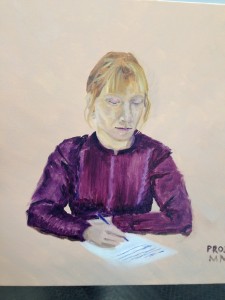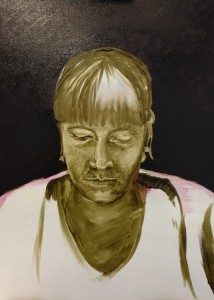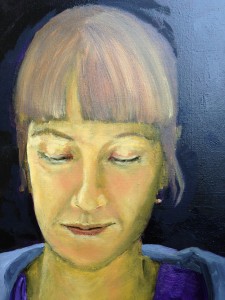|
 I recently persuaded a friend to sit for me for several days while I tried out painting techniques. She was writing, which meant she had her eyes down, but she was still enough that I could get a good likeness in pencil. She has an unusually long face, and pale features, and the lighting was difficult, so it was a challenge once I moved beyond pencil. I elected to follow my usual procedure of learning the forms in graphite, and then I moved onto an a la prima oil painting on a flesh toned canvas. This allowed me to scrape thinly with paint, which meant I could erase errors with a brush that had white spirit on it. I recently persuaded a friend to sit for me for several days while I tried out painting techniques. She was writing, which meant she had her eyes down, but she was still enough that I could get a good likeness in pencil. She has an unusually long face, and pale features, and the lighting was difficult, so it was a challenge once I moved beyond pencil. I elected to follow my usual procedure of learning the forms in graphite, and then I moved onto an a la prima oil painting on a flesh toned canvas. This allowed me to scrape thinly with paint, which meant I could erase errors with a brush that had white spirit on it.
I blocked out the face, filled bits in, and painted the darkest part of the lip shadow thick, then scrubbed it back with paint. Most areas had one layer of paint, some had two and some had none, and remained the background colour, allowing the image to harmonise with the background. The model being very thin, I had a failure in an interesting way. He shoulders are the right proportion, but the foreshortening on her arms was not sufficient, and that meant that her body looks too small. I compounded that with a hand that was sized wrong. (As she was writing with it, I did not want to spend too long on just that part.) Nevertheless, I got what I wanted out of it, which was a pleasant-looking representation of the model, that looked enough like her to be called a portrait. After that, I went on to the tougher work.
 I sat down to do my first classical chiaroscuro underpainting, modelling the forms I could see in green and white, on a primed board. I had some success with this as a still life technique, but fond it far more difficult when pressed for time with a complicated subject. She looks too round-faced, because I did not recede the corners of the jaw enough. The main problem was the all-over lighting from the gallery where I was doing my work, but tiny alterations in position became hard to pin down. I sat down to do my first classical chiaroscuro underpainting, modelling the forms I could see in green and white, on a primed board. I had some success with this as a still life technique, but fond it far more difficult when pressed for time with a complicated subject. She looks too round-faced, because I did not recede the corners of the jaw enough. The main problem was the all-over lighting from the gallery where I was doing my work, but tiny alterations in position became hard to pin down.
I left the hair mostly undeveloped and put in a very dark purple background modified with a bit of the green. It was close enough to black to look that way at casual inspection. I left the painting in that state over the weekend to dry, and did a second coat on Monday. The problems with brush marks in the green indicate I had not got the right mix, and I found it was harder to scrub out on the board, either because of the paint or because there was no weave to slow down and absorb the white spirit. I really disliked my underpainting, which is something that happens very rarely. Finding a suitable green underpaint is a priority for this particular style. I want it to be something I can use without mixing it, as purity of colour is likely to be important on the later stages, when the green is mostly covered.
 The next layer saved the painting for me, as I managed to cover up the points where the green was not strong enough. I had been keeping a list of the problems and potential solutions, so I knew what I had to solve. The sketches and the previous painting meant I knew enough about the face I was representing to override the guides I had created in the layer below. The next layer saved the painting for me, as I managed to cover up the points where the green was not strong enough. I had been keeping a list of the problems and potential solutions, so I knew what I had to solve. The sketches and the previous painting meant I knew enough about the face I was representing to override the guides I had created in the layer below.
Again the hair just got blocked in, as the exercise was for the face and in particular the skin. I used a fan brush to streak the hair and called it done. The skin was a combination of pale ochre, titanium white and crimson, keeping to a very simple colour scheme. The crimson was one of the paints I had used for the background, to tie it together. I painted over in patches of pink or pale yellow, glazing towards the edges where the shadows were. I should have been able to glaze over just about all of it, but I had to paint solidly to counteract the underpainting’s shortcomings. I consoled myself with the fact that titanium white is highly opaque anyhow, and that I was just doing what it was designed for. Nevertheless, I think the light/shadow intersections came out best.
After I had the main shapes, I darkened the lip shadow, shaped the mouth a little, and scumbled the lighter parts on the eyes, painting wet in wet to get the shiny effect. In total I spent about three times as long on that painting as on the first one, but for a totally different effect.
|